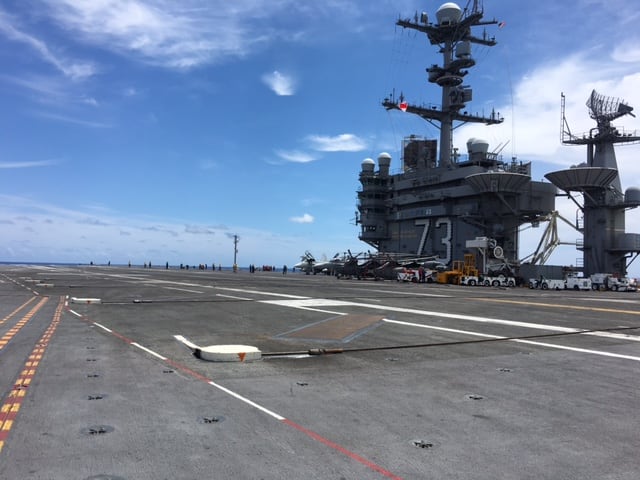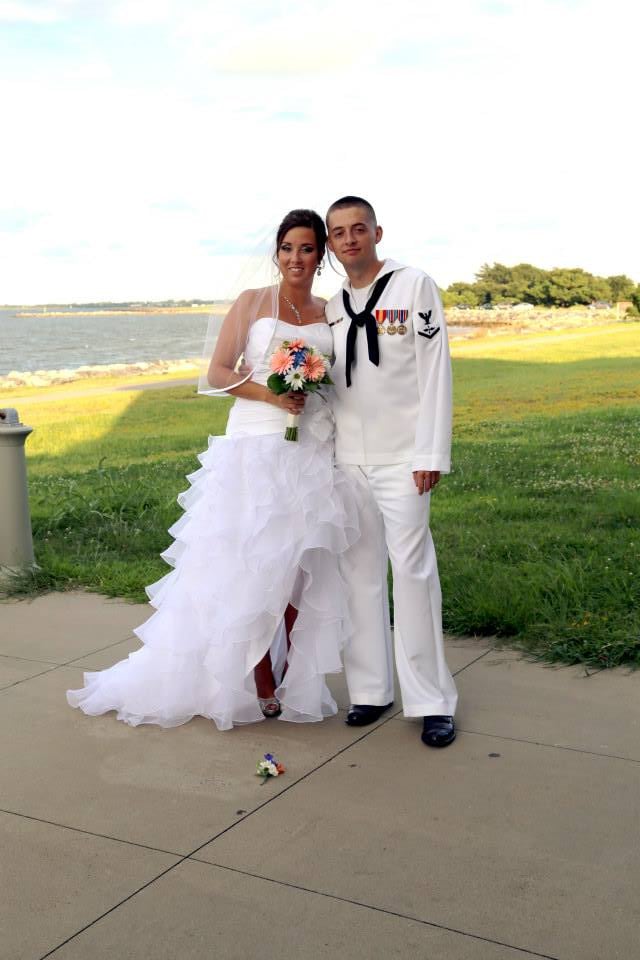The Navy faulted flawed maintenance for the rare arresting cable snap that injured eight sailors and nearly sent an E-2C Hawkeye plunging into the ocean in March. Harrowing video released Friday by the Navy shows a routine aircraft carrier landing gone horribly wrong, when an E-2C Hawkeye hits the deck and continues rolling right off the edge. Meanwhile, sailors take off running to avoid being hit by a snapped arresting cable before turning back around to help their injured shipmates.
The 30-second incident, a rarity in terms of flight deck accidents, required six medical evacuations of eight injured sailors and caused more than $200,000 worth of damages to the carrier Dwight D. Eisenhower and nearby aircraft on deck, according to a new report, which blamed this mishap on complicated maintenance rules and sailors' mistakes. , all because of an improperly calibrated cable, according to a report obtained Friday by Navy Times through Freedom of Information Act request.
Three Hawkeyes from Carrier Airborne Early Warning Squadron 123 were working on pre-deployment carrier landing qualifications off the coast of Virginia on the afternoon of March 18 when the pilots of one of the 60-foot propeller planes noticed that despite a textbook landing — hooking the fourth and final arresting cable on the flight deck — the aircraft wasn't slowing down.
"All three mishap aircrew heard a loud bang, heard the tailhook re-contact the flight deck, and felt a shudder," according to the new report. "Both pilots realized that 'something' had happened and observed that they were continuing to roll towards the end of the landing area."
A video released with the report shows the terrifying moments as flight deck sailors rushed to avoid being struck by the snapped metal wire while the Hawkeye rolled off the deck. It went missing for a frightening second, as the pilots struggled to get airborne again. The plane came within 20 feet of strike the water, the report said. going missing for a frightening second as the pilots regained lift.
The Hawkeye plunged off the edge, getting airborne again about 10 to 20 feet above the water, according to the investigation.
Meanwhile, the No. 4 wire snapped and swung across the flight deck, hitting eight sailors and causing injuries from minor lacerations to broken bones and a cracked skull, some of which the sailors are still healing from months later.
"He went to go look to see if it had caught the wire, and right as he was turning to look, he saw it snap and take out a yellow shirt and then whip back and hit a plane, and then came for him and the other guys he was working with," Katherine Cummings, the wife of 23-year-old Aviation Machinist's Mate 2nd Class Jason Cummings, told Navy Times. "He said he only had time to say 'oh crap' before it hit him and took him down and dragged him 10 to 15 feet by the propeller. It hit him so hard it knocked the lens out of his goggles."
Cummings nearly lost his leg and is still making regular emergency rooms trips to help manage his pain.
"He's just grateful he is alive and got to keep all his body parts," his wife said.
The accident also causeddid hundreds of thousands of dollars worth of damagesd to a C-2 Greyhound and MH-60S Knighthawk parked on the flight deck.
The investigation laid the blamed with three sailors responsible for maintaining the landing gear, as well as the needlesslyunnecessarily complicated procedures required to do that job. The sailors were recommended for discipline, but did not say what actions were taken. Officials removed their identities from the report out of privacy concerns.

Sailors failed to properly fix an error on the Ike's No. 4 wire, which left the arresting gear engine unable to provide enough load to stop the E-2C Hawkeye landing on deck. It narrowly missed crashing into the water. This image shows the arresting cable layout on the carrier George Washington.
Photo Credit: Meghann Myers
What went wrong
The one-inch wire ropes laid out across a carrier's flight deck that catch aircraft tail hooks — known as cross deck pendants — are programmed to release a set amount of cable as the aircraft's tail hook drags them behind the plane from the deck below, to absorb the force of a landing before spooling back up.
Below deck, a purchase cable is attached to each side of the deck pendant to absorbs the force of the landing plane, controlled by an arresting gear engine.
On March 18, the engine was miscalibrated and couldn't absorb the energy caused by the landing, which transferred the load to the deck pendant, snapping the left side and sending it whipping across the flight deck.
That happened, Naval Air Force Atlantic determined, because of some shoddy maintenance done on the No. 4 cable earlier that day, which had shown an error code the last time it'd been hooked.
Three sailors working below deck on the arresting gear were blamed for improperly troubleshooting the error code, missing at least one but possibly two steps, the investigation found, which resulted in a reprogrammed system.
The sailors were not charged with negligence because they believed they had followed the procedure, according to the report. They were, however, recommended for administrative action, including letters of instruction, special fitness evaluations or removal of qualifications.
The report did not say how the sailors were dealt with, but did confirmed that commanding officer Capt. Paul Spedero had handled it.
The investigator also came down hard on the maintenance procedure that led to the error, calling it "over-complicated, difficult to execute and does not provide requisite technical explication or any indication of the high consequence nature of its output. While, if executed verbatim, it is technically correct, it is not remotely user friendly or easily executable in the operational environment."
In addition to retraining sailors on arresting gear and aircraft launch and recovery, the report recommends adding warnings to the troubleshooting process and creating new local operating procedures for the ship.
Aftermath

AD2 Jason Cummings will need as long as a year to recover from injuries in the March 18 cable accident on the Ike. Cummings is seen here with his wife Katherine.
Photo Credit: Courtesy photo
"The first people who probably rendered care to the sailors were their friends on the flight deck," according to the carrier George Washington's senior medical officer, who wasn't aboard Ike at the time.
Mass casualty drills are practiced regularly, Lt. Cmdr. Robert Krause told Navy Times during an April underway on GW, though there is no specific training for parting cables.
Commands can, however, pick and choose scenarios to go over for each drill, whether it's a terrorist attack, a flight deck fire or another emergency.
"I would not be surprised, when we do our next drill here, is that's part of the training," he said. "Like anything in the military, there will be lessons learned."
Once the ship began its response, sailors were moved to the hangar bay for initial treatment, whileith those who couldn't walk were lowered on litters via weapons elevator.
Six of the eight injured sailors were airlifted via MH-60S helicopter from Ike, four to Naval Medical Center Portsmouth and two for more acute trauma care at Sentara Norfolk General Hospital. Another sailor was sent to Portsmouth two days later for a possible traumatic brain injury.
Injuries ranged from a broken ankle and a sprained ankle to the much more serious wounds. Two sailors had breaks in both of their legs.
One sailor suffered a fractured skull, multiple non-operable facial fractures, a pulmonary contusion, a fractured pelvis, a broken shin bone and trauma to his genitals, according to the report.. He also damaged both knees, with tears to both his anterior cruciate ligaments, a torn medial collateral ligament and a torn iliotibial band.
Cummings came away with a broken right leg, a dislocated lower left leg and a collapsed artery in his left knee, which caused nerve and ligament damage. Doctors used part of an artery from his thigh to replace it, which complicated recovery when a skin graft became infected.
He's been in and out of the emergency room a more than a dozen times in the last four months for extreme pain, his wife said.
Meanwhile, his wife is balancing taking care of Cummings, their toddler son and working a couple times a week as a patient care representative at Sentara. He's looking at a year to a year at a half recovery, she said, including physical therapy sessions during the week and a possible surgery on his left knee.
In the meantime, she said, his chain of command, his shipmates and their spouses have all reached out to offer support.
"He;s been so optimistic and says there is always a silver lining, and God has a plan for everyone and everything," she said. " There was a reason this happened to him — we might not see it now but we will."
Ike's cable snap was the Navy's first in 11 years, after six were injured during an F/A-18 Hornet landing aboard the carrier Kitty Hawk in 2005.
The Eisenhower Carrier Strike Group and its air wing, including VAW -123, left for deployment on June 1. The group launched combat sorties in support of Operation Inherent Resolve from the Mediterranean Sea before arriving in the Persian Gulf on Tuesday.
Meghann Myers is the Pentagon bureau chief at Military Times. She covers operations, policy, personnel, leadership and other issues affecting service members.



